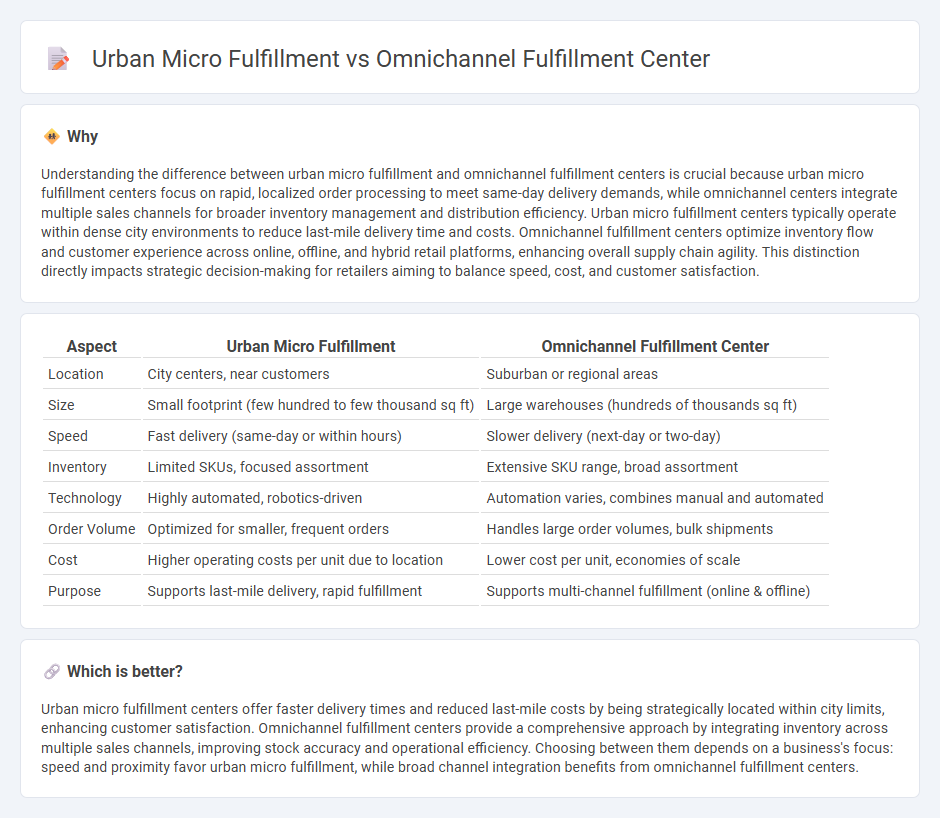
Urban micro fulfillment centers prioritize rapid delivery within densely populated areas by leveraging compact facilities and automation technologies to reduce last-mile delivery times. Omnichannel fulfillment centers integrate inventory and order management across multiple sales channels, optimizing stock allocation and improving overall customer experience. Explore the key differences and benefits between these fulfillment strategies to enhance your supply chain efficiency.
Why it is important
Understanding the difference between urban micro fulfillment and omnichannel fulfillment centers is crucial because urban micro fulfillment centers focus on rapid, localized order processing to meet same-day delivery demands, while omnichannel centers integrate multiple sales channels for broader inventory management and distribution efficiency. Urban micro fulfillment centers typically operate within dense city environments to reduce last-mile delivery time and costs. Omnichannel fulfillment centers optimize inventory flow and customer experience across online, offline, and hybrid retail platforms, enhancing overall supply chain agility. This distinction directly impacts strategic decision-making for retailers aiming to balance speed, cost, and customer satisfaction.
Comparison Table
| Aspect | Urban Micro Fulfillment | Omnichannel Fulfillment Center |
|---|---|---|
| Location | City centers, near customers | Suburban or regional areas |
| Size | Small footprint (few hundred to few thousand sq ft) | Large warehouses (hundreds of thousands sq ft) |
| Speed | Fast delivery (same-day or within hours) | Slower delivery (next-day or two-day) |
| Inventory | Limited SKUs, focused assortment | Extensive SKU range, broad assortment |
| Technology | Highly automated, robotics-driven | Automation varies, combines manual and automated |
| Order Volume | Optimized for smaller, frequent orders | Handles large order volumes, bulk shipments |
| Cost | Higher operating costs per unit due to location | Lower cost per unit, economies of scale |
| Purpose | Supports last-mile delivery, rapid fulfillment | Supports multi-channel fulfillment (online & offline) |
Which is better?
Urban micro fulfillment centers offer faster delivery times and reduced last-mile costs by being strategically located within city limits, enhancing customer satisfaction. Omnichannel fulfillment centers provide a comprehensive approach by integrating inventory across multiple sales channels, improving stock accuracy and operational efficiency. Choosing between them depends on a business's focus: speed and proximity favor urban micro fulfillment, while broad channel integration benefits from omnichannel fulfillment centers.
Connection
Urban micro fulfillment centers enhance omnichannel fulfillment by enabling rapid, localized inventory storage and order processing, which reduces last-mile delivery times and costs. These centers strategically place products closer to urban consumers, supporting seamless integration across online and offline sales channels. The synergy between micro fulfillment and omnichannel strategies optimizes supply chain efficiency and improves customer satisfaction by ensuring faster, more flexible delivery options.
Key Terms
**Omnichannel Fulfillment Center:**
Omnichannel fulfillment centers integrate inventory management, order processing, and shipping across multiple sales channels, ensuring seamless customer experiences whether shopping online or in-store. These centers leverage advanced technology and centralized locations to handle large volumes of diverse product assortments efficiently, driving faster delivery times and reducing operational costs. Explore how omnichannel fulfillment centers can transform supply chain efficiency and customer satisfaction in modern retail.
Inventory Synchronization
Inventory synchronization in omnichannel fulfillment centers relies on centralized systems to maintain real-time stock accuracy across multiple sales channels, ensuring seamless order processing and minimized stockouts. Urban micro fulfillment centers prioritize rapid inventory turnover with localized stock management, optimizing availability for same-day delivery while facing challenges in broader inventory integration. Explore the key differences and strategic benefits of inventory synchronization in these models to enhance your supply chain efficiency.
Order Orchestration
Omnichannel fulfillment centers integrate various sales channels including online, in-store, and mobile, optimizing order orchestration through centralized inventory management and advanced analytics to ensure seamless customer experiences across multiple platforms. Urban micro-fulfillment centers prioritize speed and proximity, using automated systems to manage smaller inventories close to high-density urban areas, significantly reducing delivery times and last-mile costs. Explore how these strategies transform supply chain efficiency and customer satisfaction in the evolving retail landscape.
Source and External Links
Omnichannel order fulfillment - An omnichannel fulfillment center uses a single location and workforce to manage inventory available to all sales channels (e-commerce, stores, wholesale) simultaneously, optimizing picking and packing to serve different customer order types from one system efficiently.
What Is Omnichannel Fulfillment? - It is a strategy to manage and complete orders across multiple sales channels using centralized inventory and systems, enabling options like buy online pickup in-store (BOPIS) and streamlined returns to create a seamless customer experience.
Omnichannel fulfillment vs. multichannel fulfillment - An omnichannel fulfillment center integrates all sales channels into one inventory and order processing system, unlike multichannel fulfillment which uses separate inventories per channel; this approach improves efficiency and supports options like in-store pickup and unified returns.
 dowidth.com
dowidth.com